- Back to Home »
- windows tricks »
- Merge Two Partitions in Windows
Posted by : Unknown
One common complaint that I get from friends and family is that their computers with default system configurations from Dell, HP, etc often times make the C partition too small and therefore forcing customers to figure out a way to extend the partition in order to get more free space.
Unfortunately, when you search about merging partitions, the vast majority of solutions suggest you download third-party software to mange making changes to Windows partitions. With all the choices and options, it quickly becomes a daunting task for the average PC user.
In this article, I’ll try to show you a simpler and easier way to merge two partitions without any third-party software. It’s not as robust as using a third-party and in some situations you will have to use a separate program, but it will get the job done for most people.
Basically, what we do is backup the second partition, then delete it, then extend the first partition to include the free space created when we deleted the second partition. Here’s how we do it in Windows 7.
Merge Partitions in Windows 7
First, right-click on Computer on the desktop and choose Manage.
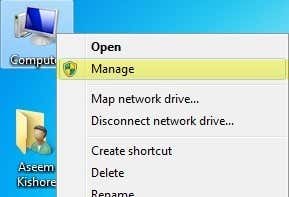
Next click on Disk Management in the left hand navigation pane:
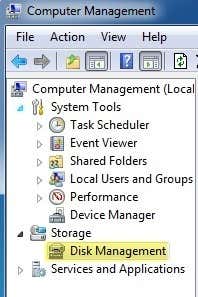
Now on the right hand pane, you’ll see a list of volumes at the top and the list of disks at the bottom.
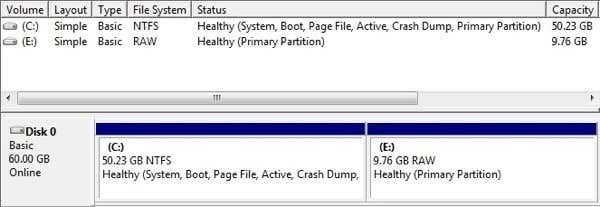
As you can see in the example above, I have a C and E volume. The C volume is my System partition that includes the operating system and paging file. The E volume is just a second primary partition that’s about 10 GB in size. What we want to do here is to merge these two partitions so that the C partition becomes 60 GB instead of 50 GB.
The first thing we need to do is to right-click on the E partition at the bottom and choose Delete Volume.

You’ll get a warning stating that deleting the volume will erase all data on it. You should make sure you have backed up anything on that volume first before you do this. Once you delete it, you’ll see it becomesUnallocated space.

Now to merge the partitions, simple right-click on the partition you want to extend (C in my case) and chooseExtend Volume.
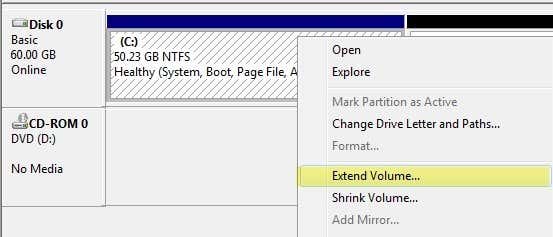
The wizard will open, so click Next. On the Select Disk screen, it should automatically select the disk and show the amount from any unallocated space.

As you can see, the wizard found 9999 MB of unallocated space which I can use to extend the C volume. Click Next and then click Finish. Now you’ll see the first partition (C volume) has been extended and includes all the space on the disk.
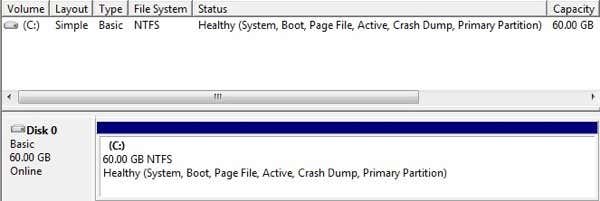
That’s it! Yes, with this method you have to delete a partition and back up the data, but at least you don’t have to worry about any third party software and paying for anything. It’s not too hard to just copy some data to an external hard drive and then copy it back later. If you have any questions, post a comment! Enjoy!
Categories
Blog Archive
-
2014
(79)
- August (1)
- June (5)
- May (20)
-
April
(43)
- Basic Terminal Commands For Linux
- Websites To Learn Computer Programming Languages
- Keyloggers And How To Be Safe From Keyloggers
- 6 Most Common Password Cracking Methods And Their ...
- What Is Phishing And How To Be Safe From Phishing ?
- Remove All Your Google Web History
- Hide Files Behind The Images
- Best Call Recorder for iPhone to Record Conversations
- jailbreak iDevice running iOS 7 using evasi0n7 [Wi...
- Add Folders and Software to My Computer in Windows...
- Make any Window transparent using a keyboard Short...
- Get Taskbar transparency in Windows 8
- View India in 360 with WoNoBo.com or with there An...
- How to Block Ads on Android Apps, Games and Browser’s
- Retrieve Your Wireless Network Security Key in Win...
- Use Alternate DNS Servers In Windows For Faster In...
- Use The Google Chrome Flash Plugin in Firefox in U...
- Encrypt Your Flash Drives In Ubuntu Linux Using Di...
- Use Google Chrome As The Default PDF Viewer In Ubuntu
- Change the GNOME Keyring Password For Easier Autom...
- Add a New Default Search Engine To Google Chrome W...
- Change the Default LightDM Background Image In Ubuntu
- Turn Off The Startup Sound In Windows Vista and Wi...
- Find, View and Analyze BSOD Dump Files
- Disable Aero (Permanently or Temporarily) in Windo...
- Change the Windows 7 Login Image without Editing t...
- Getting Started With Google Drive For Windows
- Use Google Web Fonts in the Google Docs Word Proce...
- Merge Two Partitions in Windows
- Change Where Chrome Downloads Files To
- View Photo EXIF Metadata on iPhone, Mac, and Windows
- Track Your iPhone, iPad, and Mac Computer
- Remove Duplicate Contacts on iPhone
- Create a Multiple Operating System Bootable USB Drive
- Guide to Taking Screenshots in Windows 8
- 99 Ways to Make Your Computer Fast
- Tips to Avoid Installing Browser Extensions with A...
- Some methods to Make Sure No One is Monitoring You...
- Get back the corrupted files in pendrive without a...
- Download YouTube videos using VLC media player wit...
- HIDE A FOLDER IN NOKIA PHONE WITHOUT ANY SOFTWARE
- Some Common Internet Error Codes With Meanings
- CCleaner is Now Available for Android
- March (10)








